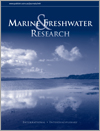The otoliths (ear stones) of an exceptionally large alligator gar revealed an estimated age of 95 years. A previous study validated the lifespan of this species to 60 years using bomb-produced radiocarbon from nuclear testing. Our study revised the maximum recorded length to 2.6 m based on a historical photograph and used new radiocarbon technology to establish a 100-year lifespan for alligator gar.

Marine and Freshwater Research
Volume 75 Number 8 2024
On the basis of research data from nine provinces in the Yellow River Basin, this study explored the incentives of water-rights confirmation in agriculture and its transmission mechanism for water conservation among farmers. The research findings indicated that water-rights confirmation in agriculture influences farmers’ willingness to conserve water and the amount of investment in water conservation.
This article belongs to the collection Ecological Monitoring and Assessment of Freshwater Ecosystems: New Trends and Future Challenges.
Environmental water requirements (EWRs) are the flows required to keep aquatic ecosystems healthy. We explored whether EWRs had been met across aquatic ecosystems in the Murray–Darling Basin over the past four decades, finding that at 65% of assessed sites they had not been achieved. The most recent decade since Basin Plan legislation has seen some improvement in EWR achievement for small freshes, possibly reflecting active environmental watering. However, across most rivers of the Murray–Darling Basin, poor health of channel, wetland (including Ramsar wetlands) and floodplain ecosystems remain.
MF23172 Abstract | MF23172 Full Text | MF23172PDF (2.1 MB) Open Access Article
Land use–cover change affects habitat quality and sustainable growth. This study predicted 2030 land-use scenarios with the PLUS model and assessed habitat quality from 2010 to 2030 with InVEST in the Greater Bay Area around Hangzhou Bay. Limiting construction, protecting farmland and expanding green spaces are essential for improving habitat quality. Findings have provided insights for sustainable growth.
This article belongs to the collection Ecological Monitoring and Assessment of Freshwater Ecosystems: New Trends and Future Challenges.




